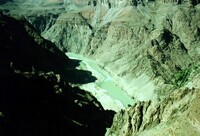Photo. Looking down to the abyss and the Colorado River in Grand Canyon. © Travel Explorations.
The sunlight shifted throughout the day continuously change the canyon's appearance. This gave the already majestic landscape a new level of magnificence.
As I descended into the canyon in 1987, it felt like stepping back through time, with each layer telling a story shaped over millions of years. Along my hike, the Colorado River often appeared far below, winding through the depths, its presence reinforcing the overwhelming scale and timeless grandeur of the canyon. It`s carved by the Colorado River.
I wondered how Indian tribes felt about living there. They have long histories in the area, with deep spiritual and cultural connections to the canyon, and some still maintain their traditional ways of life. The Pueblo people considered the Grand Canyon a holy site, and made pilgrimages to it. The first European known to have viewed the Grand Canyon was García López de Cárdenas from Spain, who arrived in 1540.
Descending into the depths of the Grand Canyon can feel like stepping into another world, almost like facing an abyss. The sense of vastness is overwhelming. As you go deeper, the walls of the canyon rise above you, towering and enclosing, while the sheer scale makes the sky seem far away. According to Wikipedia, the Grand Canyon is 277 miles (446 km) long, up to 18 miles (29 km) wide and attains a depth of over a mile (6,093 feet or 1,857 meters).
The change in perspective is dramatic—the landscape shifts from the open, windswept rim to the ancient, rugged rock layers that have been carved by time. The temperature rises significantly as you descend, and the silence is broken only by your footsteps and the distant rush of the Colorado River below.
It can feel both exhilarating and humbling, as if you're standing on the edge of something far bigger and more ancient than you. This feeling came up especially when I descended into the steep-sided canyon, and I often could observe the river far below. Then I really got the impression of the canyon’s immense depth, or shall I say abyss. I wondered how was the canyon formed? I later learned that it mostly was by the river.
The mesmerizing beauty of the Grand Canyon can make you forget just how demanding the hike really is. The descent felt quite easy, but it’s important to remember that the challenge truly begins when you turn around to hike back up. Many hikers get so absorbed in the experience—taking photos, marveling at the rock formations, and enjoying the peaceful solitude—that they don’t realize how tired their legs have become until the ascent begins.
Preparing for a hike in the Grand Canyon requires thorough planning and respect for the challenging conditions. Don`t forget that you need energy for the way back up, especially after the excitement of exploring such a unique landscape.
On our way down to the deep, one of my friend had a little bit dramatic encounter with a rattle snake. It`s not a creature you would like to argue with. So keep in mind that rattlesnakes can be dangerous because they are venomous, but they are generally not aggressive and will only bite if they feel threatened or provoked. They often use their rattle as a warning sign if humans or animals get too close.
Their bites can be painful and, in some cases, life-threatening, especially if not treated promptly. Rattlesnakes in the Grand Canyon thrive in various environments, from the canyon floor to the rim. They can often be found sunbathing on rocks or hiding in crevices. One safety tip is to stay on trails. Rattlesnakes are less likely to be encountered if you stay on well-used trails.
Take your time to embrace the beauty of one of the most iconic landscapes on Earth. With the right preparation, hiking the Grand Canyon can be a rewarding and awe-inspiring experience.
Stein Morten Lund
5th October 2024
Additional information
Hiking, trails, maps and advise. Read more on Grand Canyon Conservancy.
Dive into the five factors that make Grand Canyon a unique landscape (source: Grand Canyon Conservancy).
Based on information from National Park Foundation:
8 Facts About the Grand Canyon You Never Knew
“It has long been believed that the Colorado River began carving the Grand Canyon about 6 million years ago, but a 2012 study contained a real shocker, suggesting that the process may have begun as far back as 70 million years. In all likelihood, the Grand Canyon as we know it today started out as a series of smaller canyons 70 million years ago, but the majority of the canyon did not begin to take shape until much more recently. It's not the deepest canyon in the world. The Yarlung Tsangpo Grand Canyon in Tibet plummets to a depth of 17,567 feet, making it more than 2 miles deeper than the Grand Canyon's 6,093 feet. The Tibetan canyon is also about 30 miles longer than the Grand Canyon.”
According to Wikipedia, the Grand Canyon is 277 miles (446 km) long, up to 18 miles (29 km) wide and attains a depth of over a mile (6,093 feet or 1,857 meters).












